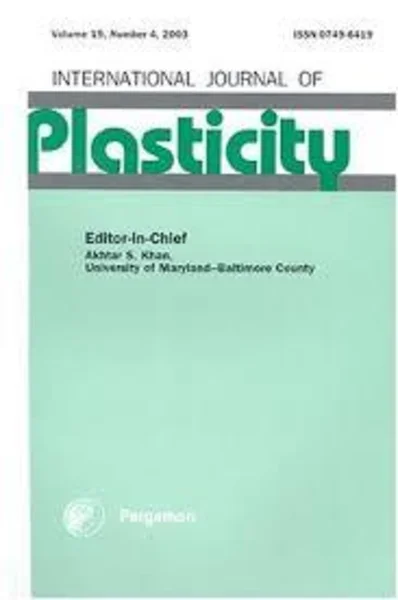-
evaluation of advanced anisotropic models with mixed hardening for general associated and non-associated flow metal plasticity
جزئیات بیشتر مقاله- تاریخ ارائه: 1390/01/01
- تاریخ انتشار در تی پی بین: 1390/01/01
- تعداد بازدید: 571
- تعداد پرسش و پاسخ ها: 0
- شماره تماس دبیرخانه رویداد: -
the main objective of this paper is to develop a generalized finite element formulation of stress integration method for non-quadratic yield functions and potentials with mixed nonlinear hardening under non-associated flow rule. different approaches to analyze the anisotropic behavior of sheet materials were compared in this paper. the first model was based on a non-associated formulation with both quadratic yield and potential functions in the form of hill’s (1948). the anisotropy coefficients in the yield and potential functions were determined from the yield stresses and r-values in different orientations, respectively. the second model was an associated non-quadratic model (yld2000-2d) proposed by barlat et al. (2003). the anisotropy in this model was introduced by using two linear transformations on the stress tensor. the third model was a non-quadratic non-associated model in which the yield function was defined based on yld91 proposed by barlat et al. (1991) and the potential function was defined based on yld89 proposed by barlat and lian (1989). anisotropy coefficients of yld91 and yld89 functions were determined by yield stresses and r-values, respectively. the formulations for the three models were derived for the mixed isotropic-nonlinear kinematic hardening framework that is more suitable for cyclic loadings (though it can easily be derived for pure isotropic hardening). after developing a general non-associated mixed hardening numerical stress integration algorithm based on backward-euler method, all models were implemented in the commercial finite element code abaqus as user-defined material subroutines. different sheet metal forming simulations were performed with these anisotropic models: cup drawing processes and springback of channel draw processes with different drawbead penetrations. the earing profiles and the springback results obtained from simulations with the three different models were compared with experimental results, while the computational costs were compared. also, in-plane cyclic tension–compression tests for the extraction of the mixed hardening parameters used in the springback simulations were performed for two sheet materials.
مقالات جدیدترین رویدادها
-
استفاده از تحلیل اهمیت-عملکرد در ارائه الگوی مدیریت خلاقیت سازمانی و ارائه راهکار جهت بهبود
-
بررسی تاثیر ارزش وجوه نقد مازاد بر ساختار سرمایه شرکت های پذیرفته شده در بورس اوراق بهادار تهران
-
بررسی تأثیر سطح افشای ریسک بر قرارداد بدهی شرکت های پذیرفته شده در بورس اوراق بهادار تهران
-
بررسی تأثیر رتبه بندی اعتباری مبتنی بر مدل امتیاز بازار نوظهور بر نقد شوندگی سهام با تأکید بر خصوصی سازی شرکت ها
-
تأثیر آمیخته بازاریابی پوشاک ایرانی بر تصویر ذهنی مشتری پوشاک ایرانی (هاکوپیان)
-
شبیه سازی مبدل حرارتی پوسته لوله e-1121 واحد تقطیر اتمسفر یک پالایشگاه نفت لاوان و تحقیق اثر تغییر پارامترهای ساختاری با هدف تعدیل قیمت ساخت
-
برآورد رفتار فرآیند تولید فنل از کیومن
-
کنوانسیون ارزیابی اثرات زیست محیطی فرامرزی (اسپو)
-
time-fractional burgers equation for dust acoustic waves in a two different temperatures dusty plasma
-
experimental study of augmented heat transfer and friction in solar air heater with different orientations of w-rib roughness
مقالات جدیدترین ژورنال ها
-
مدیریت و بررسی افسردگی دانش آموزان دختر مقطع متوسطه دوم در دروان کرونا در شهرستان دزفول
-
مدیریت و بررسی خرد سیاسی در اندیشه ی فردوسی در ادب ایران
-
واکاوی و مدیریت توصیفی قلمدان(جاکلیدی)ضریح در موزه آستان قدس رضوی
-
بررسی تاثیر خلاقیت، دانش و انگیزه کارکنان بر پیشنهادات نوآورانه کارکنان ( مورد مطالعه: هتل های 3 و 4 ستاره استان کرمان)
-
بررسی تاثیر کیفیت سیستم های اطلاعاتی بر تصمیم گیری موفق در شرکتهای تولیدی استان اصفهان (مورد مطالعه: مدیران شرکتهای تولیدی استان اصفهان)
-
ارائه مدل ارزیابی عملکرد شرکتها، تحت تأثیر ابزارهای مدیریت هزینه و بودجه بندی با تأکید بر رویکرد اقتضایی
-
تحلیل ماهیت حقوقی بهره و سود بانکی در نظام بانکی کنونی
-
نگاهی به مسائل بازاریابی شیلات و پرورش آبزیان (منطقه مورد مطالعه قصرشیرین)
-
the ear acupressure effective on pain intensity before surgery in patients undergoing appendectomy
-
effect of over time on unusual fluctuations on stock returns of companies listed in tehran stock exchange




سوال خود را در مورد این مقاله مطرح نمایید :